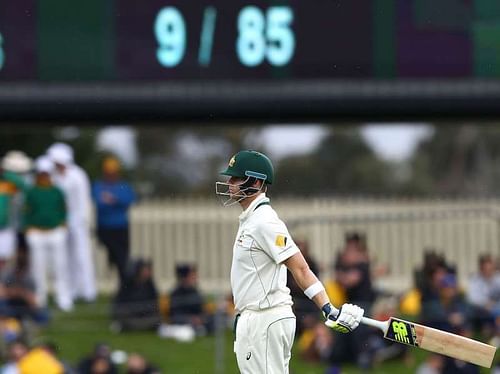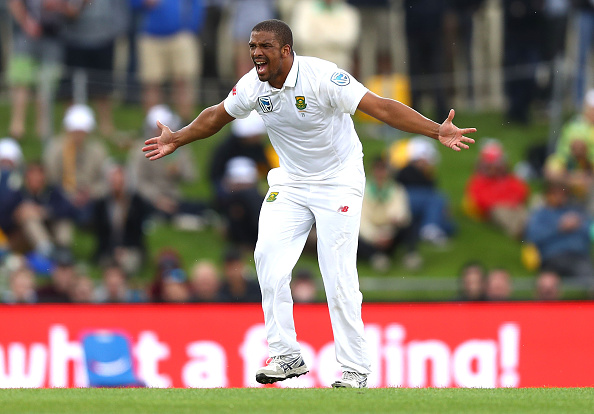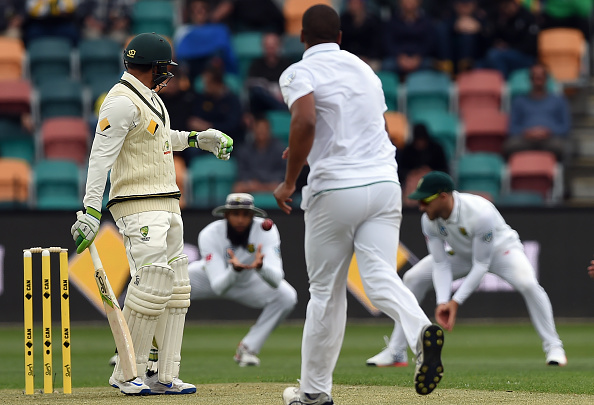
Another nightmarish experience for Australia against swing bowling

On January 3, 2010, Ricky Ponting won the toss and decided to bat first on a grassy wicket at Sydney Cricket Ground against Pakistan in the second Test. Mohammad Asif and Sami took no time to put the Australian batting line up in the soup. At one point, they were 62 for 7 and a humiliation was looming large.
Mitchell Johnson and Nathan Hauritz hung around to help Australia past 120 in the first innings. Somehow, Pakistan managed to lose the match like only Pakistani can.
Seven months later at Leeds, Ponting elected to bat first on a grassy track with a gloomy sky above. It was one of Pakistan’s home series played in foreign soil. It took 14 deliveries for Mohammad Amir to trigger a collapse and then Asif put a spell on the Aussie batsmen to leave Australia stunned. They were all out for 88 runs and lost against Pakistan in a Test after 15 years.
Also Read: Australia vs South Africa, 2nd Test, day 1- Stats: Australia surrender to Philander's magic
A few months later against England at the MCG, James Anderson, Chris Tremlett and Tim Bresnan swung the ball brilliantly on a greenish pitch under overcast conditions and skittled out Australia below hundred. Five years later, Stuart Broad did it again on another chilly morning at Trent Bridge. Australia were all out for just 60.
Overcast conditions and a bit of green tinge on the track have always given the Australian top order batsmen tough times over the years and despite so many bad experiences, it seems that they haven’t learnt from their mistakes.
On the first day of the second Test at Hobart against South Africa, the Aussies experienced nightmare again on a cold and gloomy morning.
Faf du Plessis, sent the home team to bat on a swing-friendly track without any hesitation. Vernon Philander, who had an outstanding Test match at WACA, pitched the ball full and in the right line. David Warner was patient for five balls and then went hard against a wide delivery, which was almost near the return crease, and was dismissed caught behind.
Surely, such sort of adventures were not needed on such conditions from an opener.
And sadly, that dismissal did disturb the rhythm of the Aussie batting line-up.
In the next over, Kyle Abbott jagged one back in to trap Joe Burns lbw. Usman Khawaja and Adam Voges were squared up by Philander, Rabada nailed Peter Neville, Dane Vilas chipped in with another run-out, JP Duminy and Quinton de Kock took eye-popping catches and Australia were bowled out for 85 – another first innings shame since that nightmare at Leeds six years ago.
After Allan Border took charge of Australia as the captain in the 80s, they developed the courage and technique to counter the fast and swing bowling. Border created a wonderful foundation on which Mark Taylor and Steve Waugh’s men polished themselves as one of the finest willow-wielders against fast and swing bowling which helped them to conquer West Indies, South Africa, England and Pakistan.
Be it David Boon, Dean Jones, Steve Waugh or Matthew Hayden; none of them were worried about the movement or bounce off the pitch and applied appropriate technique and temperament at the crease to frustrate the likes of Wasim Akram, Curtly Ambrose, Allan Donald and Darren Gough.
The story is different with this Australian batting side consisting of Joe Burns, Adam Voges, David Warner, Shaun Marsh, Steve Smith or Usman Khawaja. Whenever the track offers enough for the swing bowlers, they fail to script the right sort of attitude to apply the ideal technique against swing bowling.
Philander and Abbott were brilliant with the new ball, but how good was the technique of Australian batsmen remains a moot question. Except, Steve Smith, none of them, tried to cover the swing with the horizontal bat nor did they keep the bat straight when the ball was coming back in.
Again, Philander and Abbott pitched the ball further up to gain enough swing, but the Australian batters never got to the pitch of the ball to reduce the deviation time of the ball and stop catching the edge. They never got behind the ball and executed shots with hard hands.
The end result was disastrous. A clueless Steve Smith witnessed his partners get dismissed in a shambolic manner from the other end. None of them could spend time at the crease and support Smith. They lacked the fighting spirit big time and even though Mitchell Starc gave the home team the important breakthroughs, it’s very tough to defend such a small total in the first innings.
The Australian batsmen lack self-belief to play shots with the right technique and the temperament against swing bowling. Such a nightmarish performance has not happened for the first time, and the Aussies haven’t learnt from their mistakes since 2010. David Warner or Steve Smith look graceful on batting wickets, but if the track offers a challenge, they find it tough to handle.
The Australian think tank needs to fix this problem and give more importance on selecting players who are courageous and technically sound enough to represent Australia in Test cricket.

